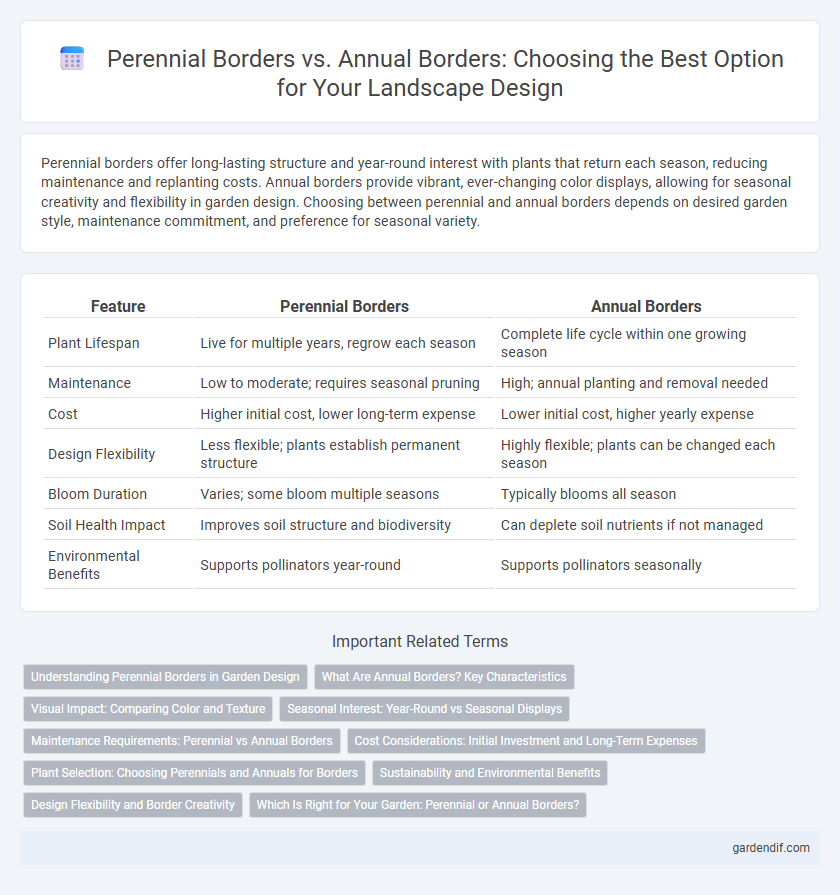
Perennial Borders vs Annual Borders Illustration
Perennial borders offer long-lasting structure and year-round interest with plants that return each season, reducing maintenance and replanting costs. Annual borders provide vibrant, ever-changing color displays, allowing for seasonal creativity and flexibility in garden design. Choosing between perennial and annual borders depends on desired garden style, maintenance commitment, and preference for seasonal variety.
Table of Comparison
| Feature | Perennial Borders | Annual Borders |
|---|---|---|
| Plant Lifespan | Live for multiple years, regrow each season | Complete life cycle within one growing season |
| Maintenance | Low to moderate; requires seasonal pruning | High; annual planting and removal needed |
| Cost | Higher initial cost, lower long-term expense | Lower initial cost, higher yearly expense |
| Design Flexibility | Less flexible; plants establish permanent structure | Highly flexible; plants can be changed each season |
| Bloom Duration | Varies; some bloom multiple seasons | Typically blooms all season |
| Soil Health Impact | Improves soil structure and biodiversity | Can deplete soil nutrients if not managed |
| Environmental Benefits | Supports pollinators year-round | Supports pollinators seasonally |
Understanding Perennial Borders in Garden Design
Perennial borders in garden design offer long-lasting structure and seasonal interest by combining plants that return year after year, reducing the need for replanting. These borders enhance soil health and biodiversity through deep root systems and provide reliable color and texture variations throughout multiple growing seasons. Selecting diverse perennial species ensures continuous bloom cycles and supports sustainable garden maintenance practices.
What Are Annual Borders? Key Characteristics
Annual borders feature plants that complete their life cycle in one growing season, offering vibrant and varied color displays throughout the year. These borders require regular replanting and provide flexibility in design, adapting easily to different themes and seasonal changes. Fast-growing annuals such as petunias, marigolds, and zinnias dominate these borders, creating dynamic and eye-catching landscapes.
Visual Impact: Comparing Color and Texture
Perennial borders create a layered visual impact with diverse textures and evolving color palettes that change seasonally yet maintain structure year-round. Annual borders offer intense, vibrant color bursts with uniform texture, providing instant visual appeal but requiring replanting each season to sustain impact. Combining both plant types can enhance garden aesthetics by balancing permanence and dynamic color variation.
Seasonal Interest: Year-Round vs Seasonal Displays
Perennial borders provide year-round seasonal interest with plants that bloom at different times and offer varied foliage textures through all seasons. Annual borders deliver concentrated seasonal displays, creating vibrant bursts of color primarily during a single growing season. Combining perennial and annual borders can maximize continuous visual appeal across the landscape.
Maintenance Requirements: Perennial vs Annual Borders
Perennial borders require less frequent replanting since they grow back each year, reducing annual maintenance tasks compared to annual borders that need complete replanting every season. Maintaining perennial borders involves periodic pruning, dividing, and weeding to keep plants healthy, whereas annual borders demand more intensive upkeep including soil preparation, fertilizing, and pest control with each new planting cycle. The long-term time and cost investment is generally lower for perennial borders due to their sustainable growth habits and resilience.
Cost Considerations: Initial Investment and Long-Term Expenses
Perennial borders generally require a higher initial investment due to the cost of mature plants and soil preparation but offer lower long-term expenses since they regrow each season without replanting. Annual borders demand a lower upfront cost per planting cycle but incur repetitive expenses annually for seeds, seedlings, and labor. Considering maintenance, perennials often reduce long-term financial outlay through less frequent replacements and sustained garden structure.
Plant Selection: Choosing Perennials and Annuals for Borders
Selecting plants for perennial borders focuses on species like hostas, daylilies, and lavender, which offer long-lasting structure, low maintenance, and seasonal blooms that return yearly. Annual borders prioritize fast-growing plants such as petunias, marigolds, and impatiens, providing vibrant color and flexibility to change designs each season. Combining perennials and annuals creates dynamic borders with enduring form and continuous visual interest throughout the growing period.
Sustainability and Environmental Benefits
Perennial borders enhance sustainability by requiring less water, fertilizer, and maintenance compared to annual borders, which need replanting each season. Their deep root systems improve soil structure and biodiversity, promoting long-term environmental health. Annual borders, while offering seasonal color, contribute to higher waste and resource consumption, reducing overall ecological benefits.
Design Flexibility and Border Creativity
Perennial borders offer long-term design stability with established plants that evolve subtly each season, allowing for consistent color schemes and structure. Annual borders provide unmatched design flexibility, as gardeners can change plant selections yearly to experiment with diverse textures, colors, and bloom times. Combining perennials and annuals can enhance border creativity by balancing permanence with seasonal novelty in landscape design.
Which Is Right for Your Garden: Perennial or Annual Borders?
Perennial borders provide long-lasting structure and low-maintenance beauty with plants that return year after year, making them ideal for gardeners seeking sustainability and established growth. Annual borders offer vibrant, seasonal color and flexibility, allowing for frequent changes in plant design to suit varying preferences and climates. Choosing between perennial or annual borders depends on your garden's aesthetic goals, maintenance capacity, and desire for seasonal variation versus enduring landscape features.
Perennial Borders vs Annual Borders Infographic

 gardendif.com
gardendif.com